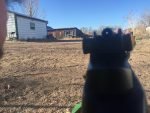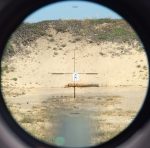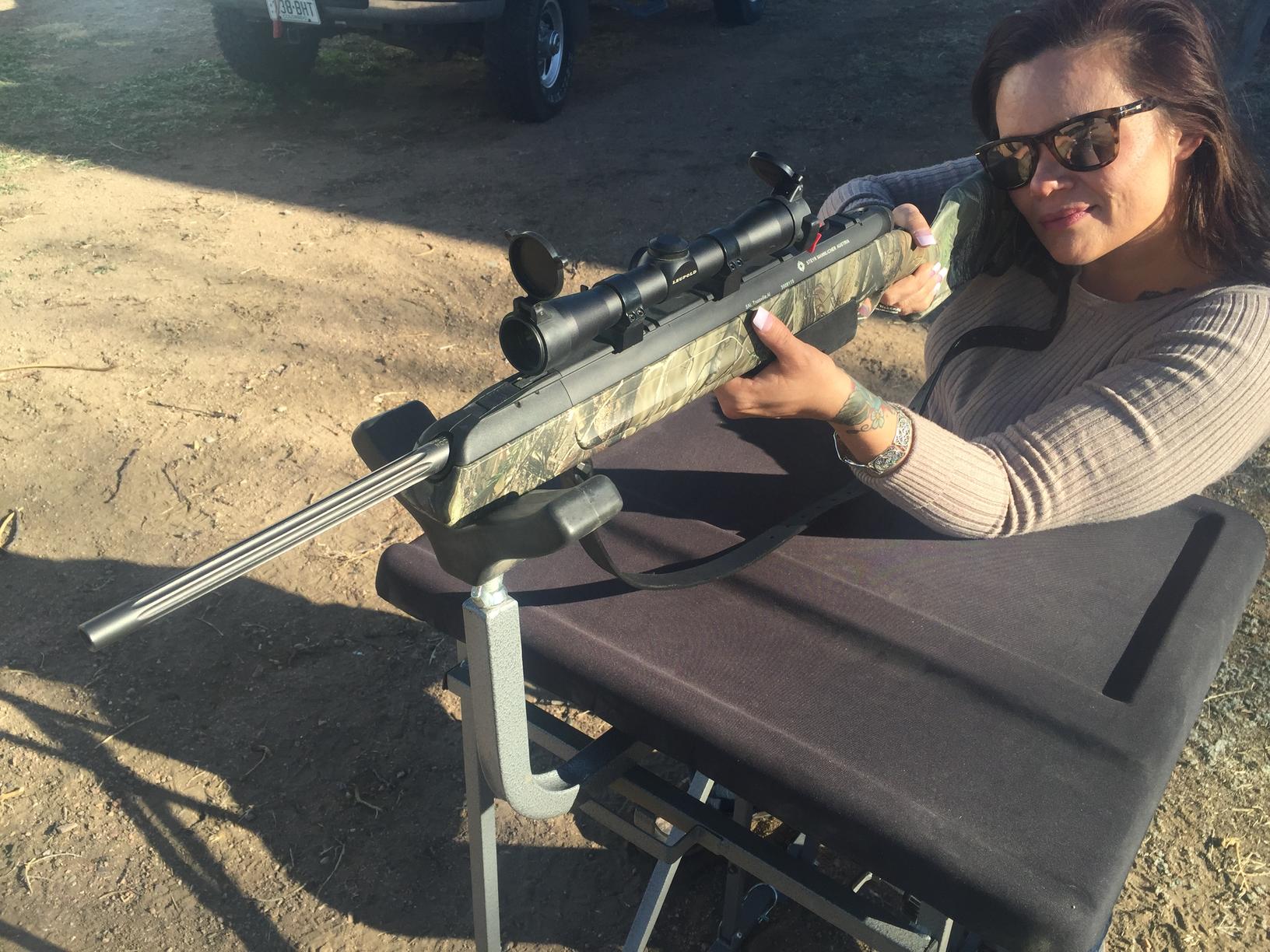Natural Respiratory Pause
One of the hardest things to teach new shooters in basic rifle marksmanship is the concept of not holding their breath. When you hold your breath, your body’s autonomic system kicks in. You start to experience rising blood pressure, pounding heart, and an ever rising heart rate. Your body does this in attempt to get you to breath. Obviously with all of this going on, your ability to aim and exercise proper trigger release becomes very difficult. This usually results in a shooter jerking the trigger and missing wildly. A typical adult at rest will take a breath every four to seven seconds. This window of time is referred to as the natural respiratory pause. This is the window you have to get your aimed rifle shot off.
Once in position, take a breath and let it out. You now have 4-7 seconds to get your shot off before you start experiencing these autonomic symptoms. If you can’t get your shot off, no problem, take another breath and reset. It takes some practice, but once you master this technique you will be amazed how much better your aim will become.
Trigger Control
You will never be very good with a firearm if you can’t learn how to concentrate. You must depress your trigger slowly and smoothly, moving only your finger tip. One of the worst things that most new shooters do is to jerk or yank the trigger harshly. This jerk movement causes their rifle to move off target, resulting in a miss or a poorly wounded animal. I believe this phenomenon is akin to buck fever. Once a new shooter perceives he has a good aim on his target he mind screams now. He jerks the trigger.
Practice is what helps shooters to learn good trigger control. Dry firing on a distant target can help shooters depress the trigger without moving their sights off their target. You need to hold your rifle in a manner that allows you to place just the tip of your finger into the meaty part of your last digit. If you put your finger past your first joint you are not going to have the needed dexterity. You will end up having to move more of your hand to pull your trigger. This results in poor trigger control and an almost certain miss.
Zeroing your rifle
One of the most misunderstood concepts of rifle marksmanship is the concept of zeroing your rifle. Most people I talk to think that a rifle shoots where you point it regardless of range. God help me, I say to myself every time I venture into the woods during hunting season. All metallic sighted rifles have what is called a mechanical zero. Elevation and windage are mechanically flat, not favoring left or right nor up and down. I can honestly say that I have only experienced one rifle in my entire life that the mechanical zero was actually my live fire zero. That happened two days ago with one of my new rifles.
We all hold our rifles a little different. And we are all built differently which is why these sights have adjustment to begin with. It is so we can zero our rifle to how we shoot. Aperture sights, such as those found on an A2 AR-15 style rifle, M1A/M14, and M1 Garand rifle, are the easiest to use and by far the most accurate of open sights available. The buckhorn sights of most lever action guns do work, but nobody would ever write a letter home to mom about how good they are.
The effect of gravity works on everything on earth including a rifle shot, which is a drop of 8.66 meters per second. This drop or arc is referred to as the trajectory of your cartridge. Once your round leaves your rifle barrel, it will rise above the bore and then fall back down to varying degrees depending on your range to your target and the length of your bullet travel. If your target is around 1000 yards away and you are shooting a .308, it is going to take approximately two seconds for your round to get there. At a gravitational pull of 8.66 meters per second, you can see how much your bullet will fall before it reaches your target.
Rifle Scopes
Using a rifle scope on your rifle is generally a good idea, but you will need to understand how they work. While allowing you to see your target better, they do not make you shoot better. Bone support, proper position, natural respiratory pause, and proper trigger control are all critical regardless of whether you have a scope or not.
Modern rifle scopes can be 1 inch/25 mm in diameter, 30 mm, 34 mm, or even 35 mm in diameter for new tactical scopes. Zeroing one of these scopes is pretty straightforward. I would recommend bore sighting your rifle prior to shooting it for zero to at least get you on paper. I prefer to have 100 yard zeroes on all my rifles. Know your cartridge ballistics very well and adjust for longer range shooting when needed.
When shooting with a rifle scope, you need to make sure you have a proper cheek weld on your rifle stock. You must also have it securely placed into your shoulder. If you don’t, you are almost certainly going to end up getting clocked in your eye when your rifle recoils. A good quality scope has between three and four inches of eye relief, and if you do your part you won’t look like your wife or girlfriend smacked you. Nikon scopes are all pretty much coming with four inches of eye relief, which is among the best in the business. Optically they are sound, if not spectacular.
Doping the Wind
Everyone would shoot High Master if it wasn’t for the damn wind. This is an advanced concept to master and takes constant practice. As you aim your rifle at your target, consider an old time clock. Your target is at 12 o’clock and you are at 6 o’clock. If the wind is blowing from 9 o’clock or 3 o’clock, your bullet’s flight will be impacted by a full value cross wind. Other points of the clock are half-value wind deflection but still affect your bullet’s flight. Wind meters can help you, but they are no guarantee of success. The wind can blow at a dizzying amount of directions between your target and where you are taking wind readings at with your new-fangled wind meter.
You need to learn to read the terrain and the foliage and mirage along the path to your target. One of the benefits to using a scope on your rifle is that you can observe conditions all the way to your target. It makes it easy to see the mirage during a warm day. If the mirage at your target appears to be rising straight up, then the wind is either at 12 O’clock or 6. It is not going to affect your bullet’s flight left or right.
If the wind is running left to right or right to left, you will have to adjust your aim either by holding into the wind or dialing, i.e. changing your windage zero to accommodate for wind drift. It takes a lot of practice to learn how to read the wind, but once you understand the concept and get some practice it does become easier and is immensely satisfying when you can look thru your scope at your target hundreds of yards away and know exactly what you need to do to hit it with a single round.
(The author, Mark Bunch, is an internationally recognized long distance competitive shooter and holds a Master Class High Power Rifle classification and has competed at Camp Perry in National Rifle Competitions.)
SurvivalBlog Writing Contest
This has been part two of a two part entry for Round 71 of the SurvivalBlog non-fiction writing contest. The nearly $11,000 worth of prizes for this round include:
First Prize:
- A $3000 gift certificate towards a Sol-Ark Solar Generator from Veteran owned Portable Solar LLC. The only EMP Hardened Solar Generator System available to the public.
- A Gunsite Academy Three Day Course Certificate that is good for any one, two, or three day course (a $1,195 value),
- A course certificate from onPoint Tactical for the prize winner’s choice of three-day civilian courses, excluding those restricted for military or government teams. Three day onPoint courses normally cost $795,
- DRD Tactical is providing a 5.56 NATO QD Billet upper with a hammer forged, chrome-lined barrel and a hard case to go with your own AR lower. It will allow any standard AR-type rifle to have a quick change barrel, which can be assembled in less than one minute without the use of any tools and a compact carry capability in a hard case or 3-day pack (an $1,100 value),
- An infrared sensor/imaging camouflage shelter from Snakebite Tactical in Eureka, Montana (A $350+ value),
- Two cases of Mountain House freeze-dried assorted entrees in #10 cans, courtesy of Ready Made Resources (a $350 value),
- A $250 gift certificate good for any product from Sunflower Ammo,
- Two cases of Meals, Ready to Eat (MREs), courtesy of CampingSurvival.com (a $180 value).
Second Prize:
- A Model 175 Series Solar Generator provided by Quantum Harvest LLC (a $439 value),
- A Glock form factor SIRT laser training pistol and a SIRT AR-15/M4 Laser Training Bolt, courtesy of Next Level Training, which have a combined retail value of $589,
- A gift certificate for any two or three-day class from Max Velocity Tactical (a $600 value),
- A transferable certificate for a two-day Ultimate Bug Out Course from Florida Firearms Training (a $400 value),
- A Trekker IV™ Four-Person Emergency Kit from Emergency Essentials (a $250 value),
- A $200 gift certificate good towards any books published by PrepperPress.com,
- A pre-selected assortment of military surplus gear from CJL Enterprize (a $300 value),
- RepackBox is providing a $300 gift certificate to their site, and
- American Gunsmithing Institute (AGI) is providing a $300 certificate good towards any of their DVD training courses.
Third Prize:
- A Royal Berkey water filter, courtesy of Directive 21 (a $275 value),
- A custom made Sage Grouse model utility/field knife from custom knife-maker Jon Kelly Designs, of Eureka, Montana,
- A large handmade clothes drying rack, a washboard, and a Homesteading for Beginners DVD, all courtesy of The Homestead Store, with a combined value of $206,
- Expanded sets of both washable feminine pads and liners, donated by Naturally Cozy (a $185 retail value),
- Two Super Survival Pack seed collections, a $150 value, courtesy of Seed for Security, LLC,
- Mayflower Trading is donating a $200 gift certificate for homesteading appliances,
- Montie Gear is donating a Y-Shot Slingshot and a $125 Montie gear Gift certificate.,
- Two 1,000-foot spools of full mil-spec U.S.-made 750 paracord (in-stock colors only) from www.TOUGHGRID.com (a $240 value), and
Round 71 ends on July 31st, so get busy writing and e-mail us your entry. Remember that there is a 1,500-word minimum, and that articles on practical “how to” skills for survival have an advantage in the judging.











Well done! Perhaps the most concise article I’ve read about the subject. I will be using this for new shooters!
Very good advice on becoming a better shooter.
From my competition days I am reminded that extreme focus is required to make those long shots. After everything else gets dialed in, and it’s just you looking down the tube, watching the mirage, settling in to that still, even breath, and shutting out the rest of the world, that you start to slowly crush the trigger inward. It is amazing how stress-relieving a match can actually be. Sure, there’s lots of things to account for before the first shot is even fired. But the way the event draws the shooter away from the things of the world, all the stress at work, the bills at home, the pain in your knees, the heat of the day, they are all swept away. It is an escape of sorts. It is incredible just how relaxed you become. You’d think it would be just the opposite. Other shooting events are more stressful, but long range shooting, just like big game hunting, pulls us into a different reality.
This article contained some good basic information and I enjoyed reading it. A point of clarification is that a bullet does not arc up as it exits the barrel unless the barrel itself is pointed up. As soon as a bullet exists the barrel,gravity pulls it to the earth.
Not so sure about this,” Once your round leaves your rifle barrel, it will rise above the bore… ”
It will definitely begin dropping as soon as it leaves the barrel, less so at first, but as you point out, more and more as the distance increases. That’s just the physics of gravity.
Otherwise this has been a fine and exceptional offering. Many thanks for taking the time to share your years of deep experience.
” Once your round leaves your rifle barrel, it will rise above the bore” Not so! It rises above the
line of sight.
As a fledgling engineer, let me state the the gravitational constant is 9.8 meters per second SQUARED. If the object falls for 2 seconds, the distance fallen is 9.8 meters time 4 (2 squared. Ballistic calculators use this constant to come up with bullet drop over distance. Other than this misstatement, the article carries many good tips.
I politely suggest you check your kinematics calculations. Mr. Metcalf states it correctly below, in terms of vertical speed of the projectile (assuming 0 m/s vertical speed at the muzzle, or barrel horizontal).
Great article. Point of clarification; the acceleration of gravity (for gravity is a change in velocity applied over time) on all objects with mass is -9.80665 meters per second squared. Or in other words, after 1 second, the object will be falling towards the center of the earth at 9.80665 meters per second. After 2 seconds, it will be falling towards the center of the earth at 19.6133 meters per second, and so on.
Also known as the 32-feet-per-second-per-second rule. So, 32 feet in the first second, and 64 fps of downward velocity by the end of the second second. So if your rifle covers 1,000 yards in 2 seconds, the average downward velocity will be the average of a curve, which is a trick to figure.
For M2 Ball (150 gr. Flat-Base FMJ @ 2750 fps), my calculator indicates about 579 inches of actual drop at 970 yards, which it reaches in 2.027 seconds. That would put the bullet about 60 minutes of angle below the bore. But with a 2-inch sight height, and 200 yard zero, it is more like 53 MOA below the crosshair.
And yes, the line of sight is always at an angle to the bore. I’m surprised how many inches of actual bullet drop can be crammed into hold-under and hold-over, with a 2-inch sight-height and a mid-range hold-under of 2 inches! It’s about 11 inches of actual bullet drop, with all impacts within 2 inches of point of aim. That would be typical of .30-06 (M2) out to about 230 yards.
GREAT article, always the nit pickers though. Keep up the good work! Looking forward to more!
All the engineering critique makes me smile. And no one discussed the salient issue here with the highest probable cause for misses. I got trained in all the artillery science which impacts ballistics like counter-rotation, air temperature, density, humidity, crosswinds, altitude, attitude, observer location, projectile weight and design, propellant type, propellant temperature, and much more. But what I learned in the biathlon competition is far more pertinent and IS addressed in your article: repeated correct and unchanging cheek weld and positioning of body and weapon, and finally controlling of heart rate and breathing. Nothing like cross country skiing as hard as you can go and then stopping to shoot in 15 and 20 KM races ever focused the techniques as well for me as that sport!
Carl, you’ve got the right idea but check your formulas. Speed (in this case vertical speed) = Acceleration times Time. Distance traveled (vertically) = 1/2 times Acceleration times Time times Time. Of course In the case of a bullet on any object falling Acceleration is the Gravitational Constant of 9.8 meters per second per second.
Mark Bunch-
Apologies for my pedantic comment on shot drop. Especially since I learned much from your post here, and could learn worlds more from you.
Thanks for taking the considerable time to create these entries. I and certainly a lot more folk are grateful.